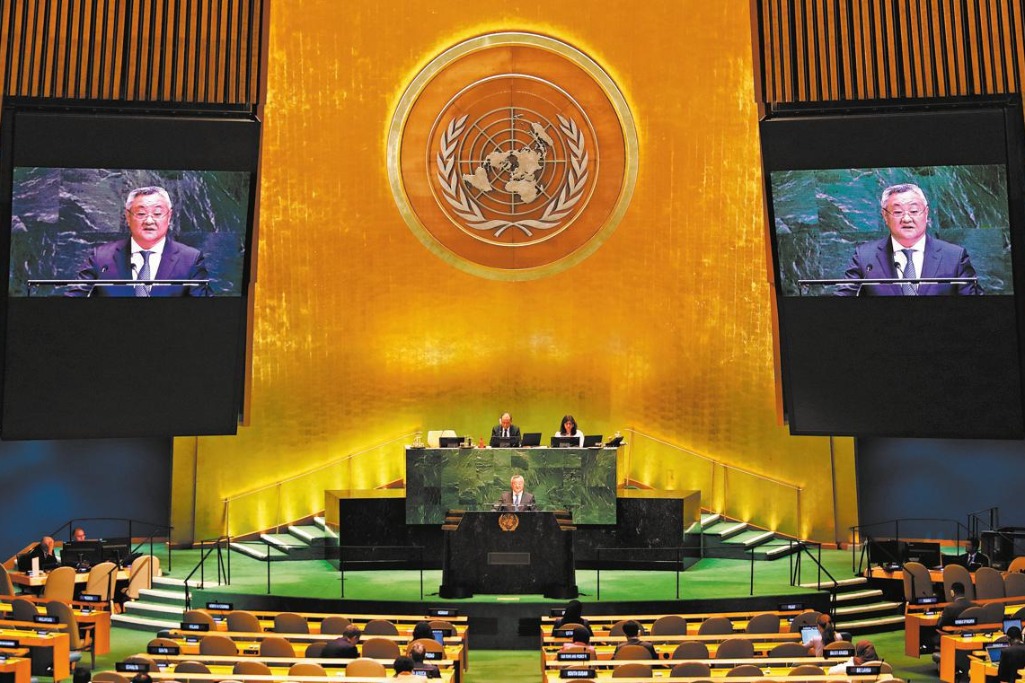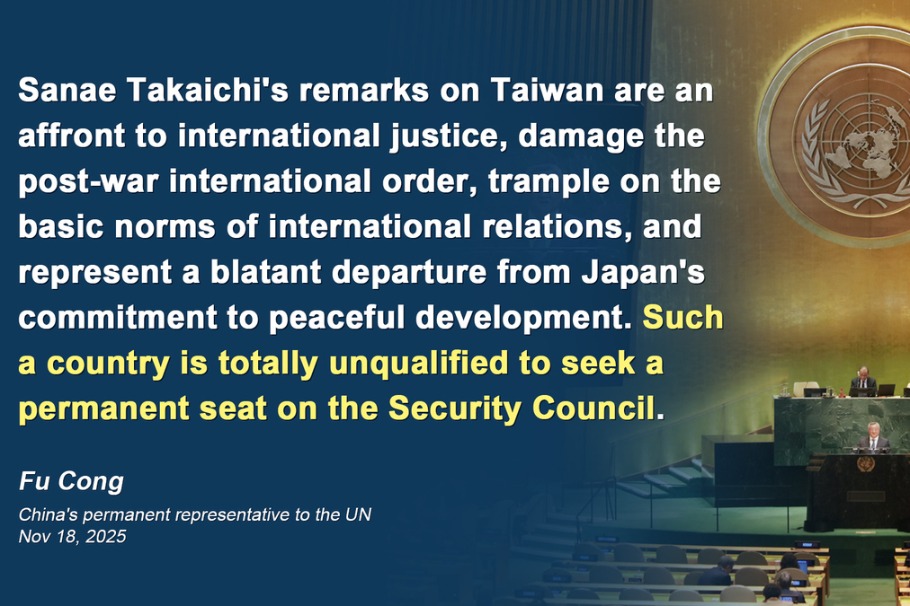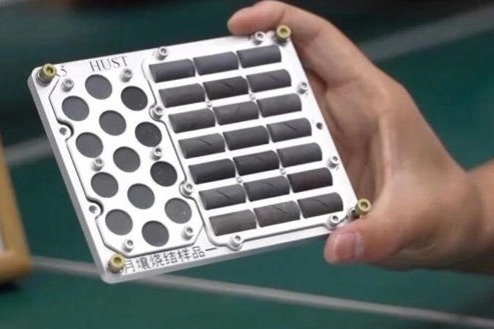Glory of frescoes lives on

| Yang Dongmiao reproduces the murals of the No 45 and No 220 grottoes of the Mogao Grottoes in Xi'an, Shaanxi province. Liu Xiao / Xinhua |
| Jin Weidong prepares pigments for the murals. Liu Xiao / Xinhua |
Two artists have dedicated their lives to reproducing the Dunhuang murals
Every stroke has been applied with loving care, with no detail left to chance. And now the splendor of Yang Dongmiao's and Jin Weidong's work, an artistic dream 20 years in the making, is about to be unveiled to the world.
At the center of the two artists' excitement as the big day approaches are two pieces of work that could dryly be called No 45 and No 220. Those are the numbers of two Mogao Grottoes that the two painters have reproduced in Xi'an, capital of Shaanxi province, in a street that celebrates the heritage of the Silk Road.
"We plan to open on Feb 25," Yang says.
About 320 square meters of murals, similar in size to those in the Mogao Grottoes, a UNESCO world heritage site in Dunhuang, in Gansu province, are almost complete and the couple are busily applying the final touches.
The Mogao Grottoes, which date as far back as AD 366, contain more than 45,000 square meters of murals in 735 caves. The grottoes are among the best-preserved Buddhist art treasures in the world.
Yang and Jin started reproducing the ancient murals in the two grottoes in 2011, as part of a tourism project to recreate some of the glory of the Tang Dynasty (AD 61-907), China's most prosperous dynasty, which chose Xi'an, known as Chang'an in ancient times, as its capital.
"We got the opportunity and financial support from the project developer to realize our long-held dream of completely reproducing the full-size murals in the No 45 and No 220 caves," Yang says.
They selected the murals in the two caves because they are regarded as among the best representatives of the Tang Dynasty grotto murals.
The murals in the two caves were a good reflection of the characteristics of that era, Yang says.
"And visitors to the replica murals can learn something about the history and enjoy the art. We duplicated the murals because the two grottoes were not open to the public."
Yang developed an interest in murals when she was a child. Her father, Yang Tongle, was an artist who worked in heritage management and research at the Mogao Grottoes for 20 years from 1951.
"My father brought back a lot of research material and many sketches of the murals in the Mogao Grottoes when he came back to Xi'an," Yang says.
"I loved to read his mural manuscripts. When I was 4 years old it was like reading picture books."
When she was 6, her father started to teach her how to draw in the style of the murals.
In 1989, Yang entered the Xi'an Academy of Fine Arts to study murals and after she graduated in 1993 she worked for a government department in Xi'an. She soon quit and joined her father's painting studio as an assistant.
From the start Yang was determined to learn the line drawing techniques and calligraphy style of the Dunhuang murals.
"I love mural art, and I want to reproduce the murals because many have been damaged by nature and for anthropogenic (human) reasons. I hope that in my reproductions people can see the glory of the ancient art."
She met her future husband Jin, at Xi'an Academy of Fine Arts, where Yang's father worked as a visiting professor of murals. In 1994 Jin visited Yang's father's studio and was struck by her concentration and dedication to her work.
In 1994 Jin accompanied Yang on her annual Dunhuang mural study trip, which she had always done alone.
Jin eventually joined Yang in studying the Dunhuang murals.
In 1995, a month after Yang and Jin were married, Yang went to Beijing to study for a master's degree in mural painting at the Art Academy of the People's Liberation Army.
In 1997 Yang's family was given five residential apartments as compensation after their house was demolished for urban construction. Yang Dongmiao was given two of the five apartments. She made two big decisions. One was to abandon her studies in Beijing to return to Xi'an, and the other was to sell her two apartments for 450,000 to invest in the reproducing the Dunhuang frescoes.
Yang and Jin rented an abandoned factory in a suburb of Xi'an for 1,000 yuan a month and started their project.
The work was tough. One day Jin fell from a 4-meter-high shelf and broke a leg. However, the couple overcame the difficulties and relished the hard work.
"Every time I stood in front of the canvas and drew, I felt like I was communicating with the ancient people and living with them," Yang says. "I am proud that in our history we have such beautiful and brilliant art."
By the end of 2000 they had reproduced 256 Dunhuang murals, at a cost of more than 1 million yuan.
In 2001 part of their work was displayed in Foshan Library in Guangdong province and was widely praised.
The exhibition's success encouraged the couple to further develop their work, and they received support from Duan Wenjie, a former director of Dunhuang Academy, who provided study materials and photos of the ancient murals.
"Some of the grottoes are not open to the public, but we received photos of all the murals with Duan's help," Jin says.
In 2011 the couple got the chance to reproduce Dunhuang murals in two caves on the Silk Road-themed street, a major challenge.
"Previously we painted the Dunhuang murals on canvas and paper," Yang says. "But this time we reproduced the entire mural on the wall. Had we made any mistakes it would have been very expensive to fix."
Preparing pigments was a laborious task.
"The pigments the original painters used came from various ores, and we had to obtain pigments the same way so our colors would be as close as possible to the original ones," Yang says.
Some have said Yang's and Jin's colors are too bright and lack a sense of history. But Jin says the colors of the original murals have faded with time.
The couple's hard work over two and a half years, with the help of students, was rewarded with a payment of 1.5 million yuan ($248,000; 183,000 euros) from the project developer.
"We will use the money to continue reproducing murals," Yang says.
"Painting them has become the focus of our lives."
Contact the writers through malie@chinadaily.com.cn
(China Daily Africa Weekly 01/24/2014 page29)
Today's Top News
- Trade-in program likely to continue next year
- Li: SCO can play bigger role in governance
- Huangyan Island protection lifeline for coral ecosystem
- Latin America urgently needs green credit
- AI innovation powers China's lead in smart eyewear
- Takaichi's provocative remarks run afoul of law
































